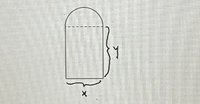I need help solving this. I only need to write the constraint equation and objective function (don't have to find the minimum cost) using variables x and y. The question states that I'm framing a door that's in the shape of a rectangle with a semicircle on top (no framing along the dotted line). I plan to use 20 ft of framing and the cost of framing for the straight edges is $2/ft and for the circular edge $5/ft. The rectangle has width of "x" and height of "y". Obviously the objective is to minimize cost and the constraint is that there's only 20ft of framing, but I don't know how to use the variables to create a function/equation for the constraint and objective.
(I've attached a photo of the shape of the rectangle if that helps as well).
(I've attached a photo of the shape of the rectangle if that helps as well).

